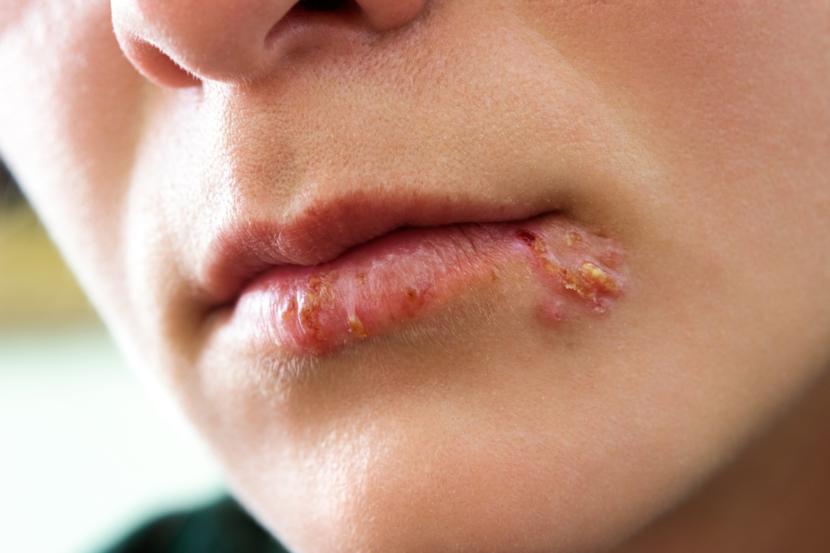What Are Cold Sores?

Cold sores are small, painful blisters that form on the lips or skin around the nose, mouth, or chin. Also called as herpes labialis and fever blisters, cold sores are caused by a herpes simplex virus (HSV) infection. It usually begins in childhood or young adulthood and continues to persist throughout the lifespan of the person possessing it. Cold sores usually cause pain, burning sensations, or itching before they burst and crust over.
About 90 percent of adults have been infected with the herpes simplex virus at some point in their lives, which makes herpes simplex infections very common. However, the first infection is not harmful and does not cause any symptoms. Reports showed that about one-third of the people who are infected with the virus develop cold sores. It must be noted that this is not a new infection but a recurrence of the first infection.
Cold sores are usually caused by type 1 HSV or HSV-1 leading to sores that develop around the mouth. Less commonly, cold sores may be caused by HSV-2 (herpes simplex virus type 2), which may be due to having oral sex with a person who has genital herpes.
Herpes simplex can spread from one person to another through close contact such as kissing, sharing utensils, and cosmetics. Cold sores are quite common and contagious, and there is no cure for it. However, there are steps that can be taken to reduce their frequency and duration.
When the herpes simplex virus enters the human body, it remains dormant or inactive for quite a long period of time. Eventually, after its dormancy period, a trigger can activate the virus and transforms into a cold sore outbreak. While triggers may vary according to each individual, one person may only have one outbreak and no recurrence, while others may have two or three outbreaks each year. Moreover, there are some people who may carry the virus and never have an outbreak because it remains dormant all the time.
The Symptoms of a Primary HSV Infection
Many people might be infected with the herpes simplex virus but have no symptoms, and will never know that they are infected unless an outbreak of cold sores occurs. If there are symptoms of a primary infection, they may become severe. For children, an HSV infection can cause symptoms during the first infection, which may last for 14 days. Children may experience dehydration and painful swallowing. In most cases, there are no detectable signs or symptoms of the infection, but when they do occur, they may be severe. The symptoms include:
- Fever
- Blisters and ulcers around and inside the mouth
- Mouth or tongue lesions
- Lip swelling
- High body temperature
- Dehydration (lack of water)
- Tiredness
- Swelling
- Sore throat
- Nausea
- Headache
- Pain in the mouth and gums
- Swollen neck glands
Severe symptoms are seen in newborn babies, people with weakened immune systems, and people with atopic dermatitis. For some people, HSV truly causes the development of cold sores. Sunlight, chest infections, influenza, hormonal changes, and physical or emotional stress are other triggering factors that can lead a person to develop cold sores.
The Symptoms of Cold Sores
- Localized itching or tingling before a cold sore appears (usually a day or two)
- Formation of small blisters
- Blisters that burst a few days after
- Pain and tenderness at the site of blisters
- Burning sensation
- The site where blisters form develops a crust
- Crusts dry up and fall off after 10 days
Cold sores can recur even without warning. It could develop more or less at the same place each time it comes back. For some people, cold sores recur when their immune system is weak such as when they are stressed or ill. Cold sores may recur often or occasionally.
Stages of Cold Sores
People who have had a cold sore outbreak can easily recognize a recurrence. There are five stages where a cold sore goes through:
- Stage 1 – There is itching and tingling 24 hours before the blisters appear.
- Stage 2 – The fluid-filled blisters erupt.
- Stage 3 – The blisters burst, seep, and develop into painful sores.
- Stage 4 – The sores start to dry out, which causes more itching as well as cracking.
- Stage 5 – The scab falls off and the sore starts to heal.
Complications
The complications that are associated with cold sores are rare but could occur, especially in children. Complications are also more likely to occur in people with a weak immune system caused by certain conditions such as AIDS, cancer, and people with eczema.
If you are experiencing high or constant fever, red and irritated eyes (with or without a discharge), or a difficulty in swallowing or breathing, call your physician immediately. Consulting the doctor at the right time will help avoid serious repercussions.
How to Prevent Cold Sores from Spreading
The most important thing to prevent cold sores is to wash your hands often. Moreover, avoiding direct skin contact with people who have cold sores is fairly important. Do not share items such as utensils, towels, and other personal items with other people. Learn what triggers your cold sores and take steps to prevent them.
Most cases of cold sore outbreaks will clear up within one to two weeks without any treatment. However, to reduce the pain and symptoms, there are some creams and antiviral medications that can slightly shorten the duration of the outbreak. Some creams that do not contain antivirals can be bought without a prescription and may help alleviate some of the irritation.
Although these creams may not speed up the healing process, they can help if the cold sores are dry, itchy, or painful. Examples of some effective creams include Bonjela, Blistex, and Cymex. They can be dabbed straight onto the sores, but the person must ensure that his hands are washed thoroughly with warm water and soap after applying the cream.
Painkillers such as ibuprofen or Tylenol (paracetamol) may also be taken to lessen the pain. Always maintain a good hygiene and cleanliness to avoid the spread of cold sores.












